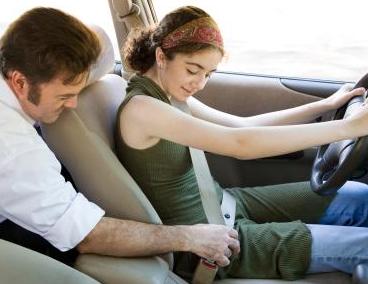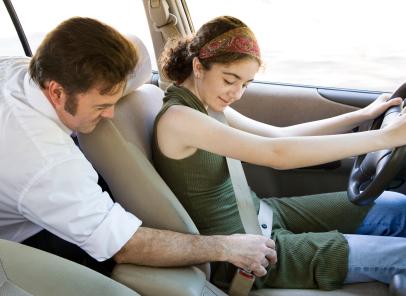 The summertime stretch from Memorial Day to Labor Day is the most dangerous time of the year for teen drivers.
The summertime stretch from Memorial Day to Labor Day is the most dangerous time of the year for teen drivers.
Over the past five years, an average of eight teens were killed in car accidents each day during the summer, according to Tire Rack Street Survival, a nonprofit teen driving education program.
“Immaturity and lack of driving experience are the two main factors leading to the high crash rate among teens,” said Loretta Worters, vice president with the Insurance Information Institute. “Even the best teenage drivers don’t have the judgment that comes with experience. It affects their recognition of, and response to, hazardous situations and results in dangerous practices such as speeding and tailgating.”
A study from the Governors Highway Safety Association indicates that deaths of 16- and 17-year-old drivers increased 19 percent between the first six months of 2011 and the first six months of 2012. If this trend continues, 2012 would be the second year in a row of increases in teen driver deaths, after eight years of declines.
Motor vehicle crashes are the leading cause of death among 15- to 20-year-olds and research shows that more than half of teens who die in crashes are passengers, most of whom are not wearing a seatbelt.
Other studies have shown that a young driver’s chance of getting in a fatal accident doubles when a teen passenger is in the car. With three or more passengers, the risk quadruples.
When it comes to teen drivers, the biggest concern is risky behavior—eating, talking on their cell phones or text messaging.
“They often don’t wear their seatbelts and the distraction of a teen passenger just adds to the risks facing young drivers. Fortunately there are steps you can take to protect your teen,” Worters said.
The I.I.I. recommends taking the following precautions to ensure the safety of teen drivers:
1. Pick a Safe Car
Choose a car that’s easy to drive and would offer protection in the event of a crash. Avoid small cars and those with high performance images that might encourage speed and recklessness. Trucks and sport utility vehicles should also be avoided, since they are more prone to rollovers.
2. Enroll Teens in a Drivers Education Course
A teenager who has learned to drive through a recognized drivers education course is viewed more favorably by insurers and may earn a discount. In some states, teens must take a drivers education course if they want to get a license at age 16; otherwise, they have to wait until they are 18. The more driving practice a teen gets, the more confident they’ll be behind the wheel and the better able to react to challenging situations on the road.
3. Enroll Teens in a Safe Driver Program
Check whether the auto insurance company offers a “safe driver” program. Teen participants in these programs sign contracts with their parents outlining the young driver’s responsibilities and the consequences of failure to meet those expectations. Teens who complete the program, might be eligible for a discount.
Insurance companies are also helping to reduce the number of accidents involving teen drivers by subsidizing the cost of electronic devices, such as GPS systems and video cameras, which can monitor the way teens drive and alert parents of unsafe driving by email, text message or phone.
4. Discuss the Dangers of Drug and Alcohol Use
Advise teens never to drink or do drugs, and not to get in a car if the driver has used drugs or alcohol. Encourage them teen to for a ride if such a situation arises, to ensure they have a safe way home.
5. Understand the Dangers of Distracted and Impaired Driving
Remind teens to never to phone or text while driving and to keep distractions, such as the radio and chatting with friends to a minimum. Teens should also be responsible passengers when in their friends’ cars. New drivers should wait 1,000 miles or six months before picking up their first teen passenger.
6. Be a Good Role Model
New drivers learn by example so if parents you drive recklessly their teenage drivers are likely to imitate them. Always wear a seatbelt and never drink and drive. Require teenagers to wear safety belts at all times—no exceptions.
7. Enroll Teens in a Graduated Drivers License Program—or Create One
Many states have been successful in reducing teen accidents by enacting Graduated Drivers License legislation. These laws, which include a three-phase program, allow teen drivers to develop more mature driving attitudes and gain experience behind the wheel.
New drivers are restricted from certain activities, such as late-night driving or having passengers in the car, until they have had their licenses for a set period. A number of states also restrict the amount of time new drivers may be on the road without supervision. For more information on GDLs, visit www.iihs.org.
Parents should take an active role in their teenagers’ driving practice and expose them to driving in a wide variety of driving conditions to build experience and confidence. If a state does not have a GDL program, parents can institute the same policies with your own children. Introduce privileges gradually. Allow independent driving only after continued practice, including night driving and driving in inclement weather.
“Parents should consider whether their child is ready to drive,” Worters said. “The law says no one under 18 can be issued a learners permit without parental permission. Keep in mind teens do not all reach the appropriate level of maturity to handle a drivers license at the same time. Parents should consider whether their children are easily distracted, nervous or risk takers before allowing them to get a license or even a learners permit.”












